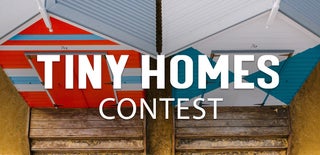Introduction: Tiny Bus House
We took a 2001 Ford E450 Bluebird Microbus and made it into a tiny little home so we could travel around the country and take our dogs with us. See the entire tour here: https://youtu.be/xGoVrEisUak
Step 1: First Things First, Get Your Layout Down.
This one is a big deal. The first thing you want to do is add your layout to see what kind of space you are working with. We started with the bedframe, and from there, we used masking tape to see what kind of space we had from there. Using masking tape is a great way to see how big everything will be before actually building it.
Step 2: Build From the Back-forward
Start building from the back to front. You dont want to be having to carry your materials over everything in the front, so start at the back. We started with our bed frame and electrical area and water tank. As you can see in this picture, our electrical area is on the left and the water tank is on the right.
Step 3: Start Adding Walls!
Start adding walls. The big thing to consider here is what material and thickness to use. We have seen a lot of people us 2x2's for walls, but we opted for more rigidity and strength in our walls and decided to go with a standard 2x4. The overall savings of 2" on one side and 4" on the other by using 2x2's instead of 2x4's wasn't nearly the justification compared the the added strength we get by regular stud walls.
Step 4: Finishing Walls and Moving Forward
You will need to select a finish for your walls. We selected pine car siding. It was cheap and thin at the local box store and looks beautiful. We added our normal house wiring as we build the walls and ran it all back to the area under the bed that we designated for electric. Next, moving towards the front of the bus, we added a composting toilet. It uses a 5-gallon bucket and sawdust, so no need for a black water tank.
Step 5: Moving Forward Again, Building a Storage Area/end Table
We added a little end table on one side where our couch was going to go so we would have somewhere to set drinks and also add a little storage area
Step 6: Making of a Kitchen
On the other side of the bus, we started building our kitchen. The sink is re purposed (we actually found it in a trash pile in the woods). We under mounted the sink, and then built the cabinet ourselves. We couldn't find a pre-made cabinet setup the size that we wanted, so this was the easiest option.
Step 7: Make a Couch...or a Bed...or BOTH
We made this simple couch bed contraption after seeing some others online. You can see the way it works by watching the video.
Step 8: Add Your Electricity
This shows our electricity setup. We have a Renogy 400w solar system powering a 3000/6000w inverter and (2) 200AH AGM Batteries. These all run into a transfer switch that allows us to run off of a generator or shore power if we cant use the batteries.
Step 9: Adding the Bed Once Everything in the Back Is Done
We waited till the very end to add the mattress so we didn't tear it up. This is an 8" memory foam mattress off Amazon. They are pretty inexpensive, come in a small but heavy box, and are super easy to get into the bus compared to a regular mattress. Then open the bag and let it expand!
Step 10: Add the Finishing Touches, Paint, and Get Ready to Explore!
Painting was probably the worst part for us because there was so many little things to paint here and there, but it has to be done! Everything inside our bus is made from either hardwood or hardwood plywood. There is no particle board in the entire bus. Everything is solid. We just got back from taking it through the mountains of Colorado and didn't have to hook up to power or water once in our week long trip. It is a fully self sufficient vehicle and we couldn't love it more.

Runner Up in the
Tiny Home Contest







